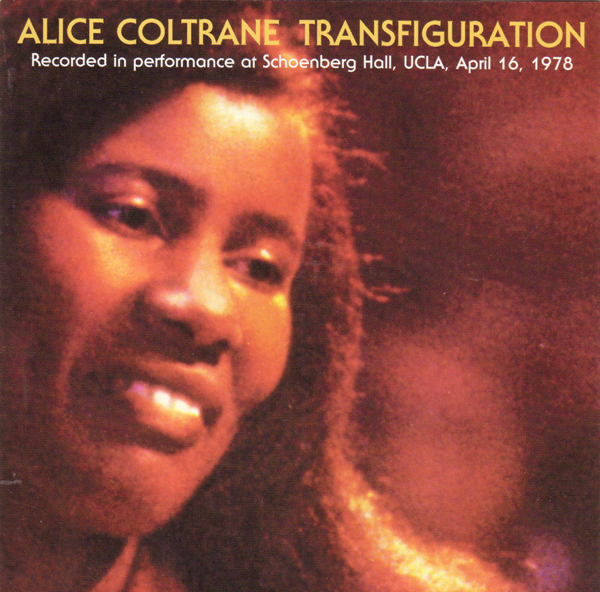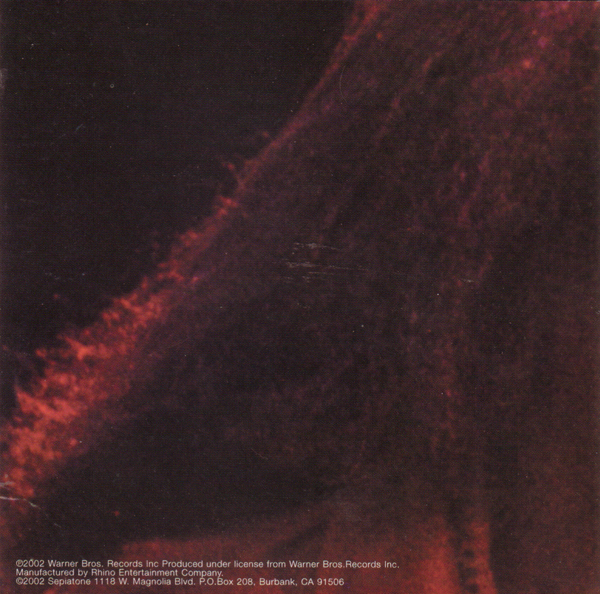ALICE COLTRANE




1/ Transfiguration (Alice Coltrane) 11.27
2/ Spoken Introduction and One For The Father (Alice Coltrane) 7.37
3/ Prema (Alice Coltrane) 9.19
4/ Affinity (Alice Coltrane) 10.49
5/ Krishnaya (Alice Coltrane) 3.38
(includes introduction of musicians and preferatory commentary on Leo
6/ Leo, Part One (John Coltrane) 16.42
7/ Leo, Part Two (John Coltrane) 20.12
Recorded in performance at Shoenberg Hall, UCLA, April 16, 1978
Strings on track 3 recorded at Westlake Audio, Los Angeles
Engineered by Baker Bigsby, with the Walter Heider location recording
truck and crew
Mixed at Westlake Audio
Produced by Ed Michel under the direction of Alice Coltrane
Mastered by Geoff Sykes at Kendun Recorders, Burbank, California
CD reissue remastered by David Cheppa
Alice Coltrane: organ, piano; Reggie Workman: bass; Roy Haynes: drums; Noel Pointer (3):
violin; Murray Adler (3): violin; Sherwyn Hirbod (3): violin; Michelle Sita Coltrane (3):
violin; Jay Rosen (3): violin; Pamela Goldsmith (3): viola; Janice Ford (3): viola; Ray
Kelley (3): cello; Christina King (3): cello.
1978 - Warner Bros. Records (USA), 2WB 3218 (2x12")
2002 - Sepia Tone (USA), STONE 01 (2CD)
Transfiguration was recorded live at UCLA in 1978, with Reggie Workman on bass and Roy Haynes on drums. To date, it is the last jazz recording that Coltrane has made. (She has made several subsequent recordings of devotional songs and chants.) In her pre-Coltrane years, Alice was reputedly quite a player of bebop, but by this stage of her career, her playing was a distant relative of those roots, with few overt traces of jazz.
Her electronic keyboard work seems far more influenced by African and Indian musics, and there are often strong affinities with the organ playing of (another devotional figure) minimalist Terry Riley. Her lengthy improvisations show little development, often using repetition and a limited dynamic range to achieve a kind of drone. If that reads like a criticism, it isn't meant to be; the combination of Coltrane's keyboards with Workman and Haynes is highly successful. They provide the flexibility and responsiveness that Coltrane needs to support her playing and stop the minimalism becoming one-dimensional.
One highlight of the album is the long closing version of John Coltrane's "Leo", with fine solos from bass and drums. Alice's long closing solo is also commendable, but the (rather dated) tone of the electronic keyboard she employs does become rather monotonous and wearying over the album's eighty minutes. For this reason, easily the best piece here is "Prema", on which Coltrane plays acoustic piano, and is joined by a nine-piece string section (overdubbed) that provides a perfect complement to her slow, gospel-tinged style. Consequently, this track works best as jazz, and also most closely approaches the universal spirituality that Coltrane seeks to convey.
John Eyles (courtesy of the BBC website)
Alice Coltrane never had an easy time of it with critics. That she was able to pursue her rugged musical vision in the midst of controversy (many claimed she was "the Yoko Ono of the John Coltrane Quartet," in that she replaced McCoy Tyner when Trane decided to shift the focus of his band) is, in retrospect, a heroic act, though, humble as she is, she would never see it that way. This double-LP live set (available on one CD from Sepia Tone) from 1976, recorded at UCLA (and not released until 1978), reveals in total the ambitious and profound free jazz and universal musical frontiers Ms. Coltrane was able to explore in both small and larger groups. The lion's share of the music here features her in a trio setting with bassist Reggie Workman and drummer Roy Haynes. Ms. Coltrane performs on piano and organ. The opening moments of the title track, which opens the album, offer the careening subjectivity through the whole-tone improvisation that Alice Coltrane made her own. Certainly there is the influence of her late husband here, but her sense of phraseological articulation and accent is far different. She moves with one hand over a difficult series of arpeggiattic concerns, creating a strong harmonic line for Workman and Haynes to develop into a rhythmic construct. When a standard modal interlude develops in the rhythm section, Coltrane stretches it to its breaking point until a new one must be developed; it's nothing less than breathtaking. But expectation is thwarted when Coltrane plays a piano solo on "One for the Father," where the depth dynamics of Shostakovich meet the strident harmonic vistas of Stravinsky and Messiaen and engage the profound spiritual emotionalism of gospel music in a seven-minute piece that is so moving, it would seem that the set should end there. But there is so much more. On "Prema," another solo piano piece which opens an Eastern drone in a near-impressionistic (à la Debussy) manner was later overdubbed with a string section, adding more dimension to the droning, whole tones that lie at its root. When the work shifts into a section that reflects transcendence, the dynamic is actually quieter and more lush and reflective than in the music's searching passages. Finally, after two more selections, the concert's finale begins, a 37-minute read of John Coltrane's "Leo." Ms. Coltrane and her band begin slowly to articulate a system devised by John, where all 12 tones were related to the 12 signs of the zodiac. Alice Coltrane's organ soloing here is very much in the angular shifting, shaping, and contouring that her husband's soprano playing had. It articulates a phrase repeatedly until every ounce of emotion and spirit have been wrung from it and then dives straight into the next. The interplay between Workman and Haynes was so telepathic, it pushed Ms. Coltrane into new realms further inside these shimmering harmonics until their shards gave way to a series of symbols and meanings that opened onto new vistas in tonal metalinguistic post-tonalism. It's an exhausting work, but one that leaves the listener in a state of near disbelief at what just transpired. If you can only own one Alice Coltrane record, this should be it.
Tom Jurek (courtesy of All Music Guide website)